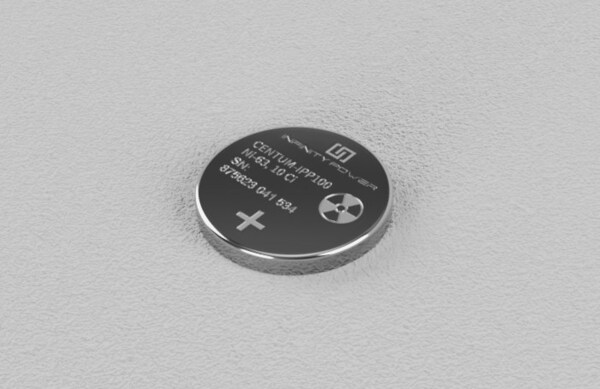The company describes its electrochemical battery as a “tiny coin-cell-style device [that] can provide tens of milliwatts of power for over a hundred years.” According to a press release issued June 11, the radioisotope is encased within “sophisticated container designs” to “guarantee adequate shielding and no leakage.”
“Our new method utilizes a highly effective energy conversion mechanism for strong power generation,” said Jae W. Kwon, founder and chief executive officer of Infinity Power.
Nickel-63: A photo released by Infinity Power indicates a 10 Ci nickel-63 source. Ni-63 is a soluble radioisotope with a half-life of about 100 years that decays by beta emissions to stable copper-63. It is produced in Oak Ridge National Laboratory’s High Flux Isotope Reactor by irradiating targets of stable Ni-62 for about two years and is commonly used in devices that allow the Transportation Security Administration to detect explosives residue.
Defense contracts: Infinity Power has fulfilled three contracts from the DOD, most recently a $140,000 Phase 1 contract from the U.S. Navy granted in 2019 for six months of work to “develop a high efficiency prototype nuclear battery that can produce long-term reliable power suitable for a wide variety of applications and systems.” According to the research abstract, Infinity Power intended to study “suitable isotopes or isomers for use in the nuclear battery along with their associated production methods and costs.”
Earlier, Infinity was awarded Phase 1 and Phase 2 contracts for a “Radiolytic Atomic Cell for Long-Lived Sensors” from the U.S. Army in response to a 2015 solicitation. First, the company received $99,897 for six months of work in 2015 and 2016 to develop a radioisotope power source that “can operate for extended periods of time and in extreme environments.”
That was followed by a Phase 2 contract valued at nearly $1 million for two years of work on the same project, allowing Infinity Power to “carry out a well-defined research plan and activities for the successful transition of a conceptual device in Phase 1 into a potentially viable commercial prototype.”
Not the first atomic battery: The company said the technology is scalable to a range of power generation levels, “from nanowatts to kilowatts or more.” A long-lived battery could power devices such as implantable medical devices, deep-sea power, space applications, remote power systems, and microgrid power systems without interruption for refueling or recharging.
Small, sealed radioisotope batteries have been developed and used before. Nuclear batteries—including some using a plutonium-238 source—were used in pacemakers in the 1970s, as Nuclear News explored in a Throwback Thursday post from Jan. 20, 2022.
A different nuclear battery developer, NDB Inc., was sued in 2023 by the Securities and Exchange Commission, which alleged NDB and its chief executive officer, Nima Golsharifi, raised over $1.2 million from investors after claiming in an August 2020 press release that it had tested its battery technology at two laboratories and had secured its first beta customers, when it had not.








